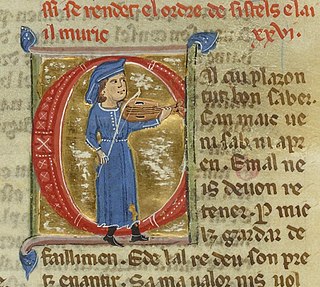
A troubadour was a composer and performer of Old Occitan lyric poetry during the High Middle Ages (1100–1350). Since the word troubadour is etymologically masculine, a female troubadour is usually called a trobairitz.

Cercamon was one of the earliest troubadours. His true name and other biographical data are unknown. He was apparently a Gascony-born jester of sorts who spent most of his career in the courts of William X of Aquitaine and perhaps of Eble III of Ventadorn. He was the inventor of the planh, of the tenso and perhaps of the sirventes.

Peire Cardenal was a troubadour known for his satirical sirventes and his dislike of the clergy. Ninety-six pieces of his remain, a number rarely matched by other poets of the age.
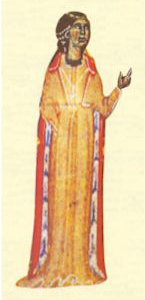
The trobairitz were Occitan female troubadours of the 12th and 13th centuries, active from around 1170 to approximately 1260. Trobairitz is both singular and plural.
The canso or canson or canzo was a song style used by the troubadours. It was, by far, the most common genre used, especially by early troubadours, and only in the second half of the 13th century was its dominance challenged by a growing number of poets writing coblas esparsas.

Cadenet was a Provençal troubadour (trobador) who lived and wrote at the court of Raymond VI of Toulouse and eventually made a reputation in Spain. Of his twenty-five surviving songs, twenty-one are cansos, with one alba, one partimen, one pastorela, and one religious piece represented. Two of his melodies survive.
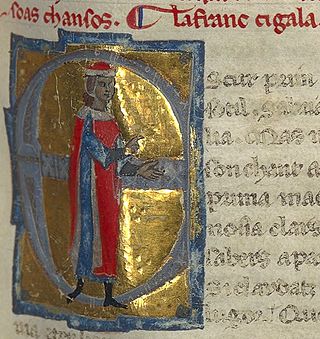
Lanfranc Cigala was a Genoese nobleman, knight, judge, and man of letters of the mid thirteenth century. He remains one of the most famous Occitan troubadours of Lombardy. Thirty-two of his poems survive, dealing with Crusading, heresy, papal power, peace in Christendom, and loyalty in love. Lanfranc represented a tradition of Italian, Occitan-language trovatori who berated the Papacy for its handling of the Crusades.

Peirol or Peiròl was an Auvergnat troubadour who wrote mostly cansos of courtly love in the late twelfth and early thirteenth centuries. Thirty-four surviving poems written in Occitan have been attributed to him; of these, seventeen have surviving melodies. He is sometimes called Peirol d'Auvergne or Peiròl d'Auvèrnha, and erroneously Pierol.

Jordan Bonel, sometimes also de Confolens, was a troubadour from western Aquitaine about whom very little is definitively known except that he was associated with the court of Alfonso II of Aragon. His vida states that he was from Saintonge and he appears to have been contemporary with Bertran de Born. His surviving corpus probably consists of three cansos, wherein only one is attributed to him, though its melody survives:

The (Lo) Monge de Montaudon, born Pèire de Vic, was a nobleman, monk, and troubadour from the Auvergne, born at the castle of Vic-sur-Cère near Aurillac, where he became a Benedictine monk around 1180. According to his vida, he composed "couplets while he was in the monastery and sirventes on subjects that were popular in the region."
Ricaut Bonomel was a Knight Templar and troubadour in the Holy Land around the time of the Eighth Crusade. He was an outspoken critic of Charles I of Naples and his attempts to secure a throne in Italy, and of the Papal policy which diverted funds intended for the Holy Land to other purposes. He was also a vocal critic of the European clergy who did not preach crusading.
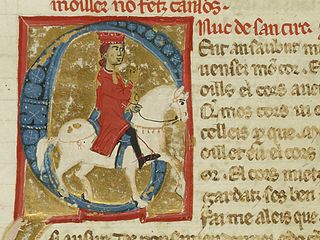
Uc de Saint Circ or Hugues (Hugh) de Saint Circq was a troubadour from Quercy. Uc is perhaps most significant to modern historians as the probable author of several vidas and razos of other troubadours, though only one of Bernart de Ventadorn exists under his name. Forty-four of his songs, including fifteen cansos and only three canso melodies, have survived, along with a didactic manual entitled Ensenhamen d'onor. According to William E. Burgwinkle, as "poet, biographer, literary historian, and mythographer, Uc must be accorded his rightful place as the 'inventor' (trobador) of 'troubadour poetry' and the idealogical trappings with which it came to be associated."

Albertet de Sestaro, sometimes called Albertet de Terascon, was a Provençal jongleur and troubadour from the Gapençais. Of his total oeuvre, twenty three poems survive. "Albertet" or "Albertetz" is the Occitan diminutive of Albert. Unqualified it usually refers to Albertet de Sestaro, but there was an Albertet Cailla.

In Old Occitan literature, a tornada refers to a final, shorter stanza that appears in lyric poetry and serves a variety of purposes within several poetic forms. The word tornada derives from the Old Occitan in which it is the feminine form of tornat, a past participle of the verb tornar. It is derived from the Latin verb tornare.
Raimon Gaucelm de Bezers was a Languedocian troubadour with nine surviving works. Many of his works appear with dates in the rubrics in manuscript C, a 14th-century work now "BN f.f. 856" in the Bibliothèque nationale de France, Paris, allowing his career to be dated with ease.
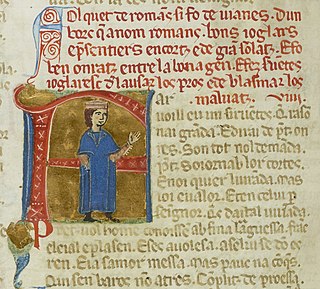
Falquetde Romans was the most famous troubadour attached to the court of Frederick II, Holy Roman Emperor, where he garnered a high reputation despite the fact that his career began as a jongleur. His surviving work consists of fourteen or fifteen pieces: seven sirventes, three tensos, two or three cansos on courtly love, a salut d'amor of 254 lines, and a religious alba. His poetry is, in general, clear and elegant, and he was apparently very religious.
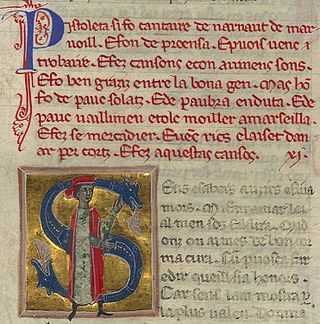
Pistoleta was a Provençal troubadour. His name means "little letter (epistle)" in Occitan. He left behind eleven songs, comprising nine cansos and two tensos. Some of his pieces are assigned to an otherwise unknown Jordan de Born in the table of contents of chansonnier C, a fourteenth-century Occitan manuscript.
A Crusade song is any vernacular lyric poem about the Crusades. Crusade songs were popular in the High Middle Ages: 106 survive in Occitan, forty in Old French, thirty in Middle High German, two in Italian, and one in Old Castilian. The study of the Crusade song, which may be considered a genre of its own, was pioneered by Kurt Lewent. He provided a classification of Crusade songs and distinguished between songs which merely mentioned, in some form, a Crusade from songs which were "Crusade songs". Since Lewent, scholars have added several classifications and definitions of Crusade songs. Scholars have argued for three different classifications of Crusade songs which include songs of exhortation, love songs, and songs which criticize the Crusading movement.

Matfre Ermengau was a Franciscan friar, legist, and troubadour from Béziers. He had a master of laws degree.
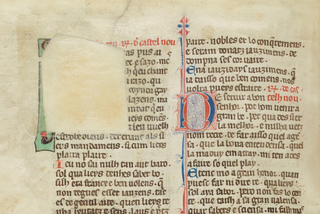
Raimon de Castelnou was an Occitan writer and troubadour of the second half of the 13th century. He wrote five cansos and one treatise on Catholic doctrine and ethics. There is a sirventes attributed to him in some manuscripts, but its attribution is disputed.